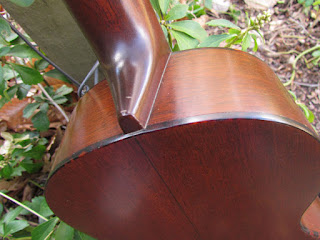 After I did a minor set-up on my 'new' Martin, I took it to the garden for some beauty shots. I'm fortunate to have snagged this one. It's in super clean condition. There are no cracks at all, and only a couple of minor dings. The finish is in great shape - only some light wear on the treble side below the soundhole.
After I did a minor set-up on my 'new' Martin, I took it to the garden for some beauty shots. I'm fortunate to have snagged this one. It's in super clean condition. There are no cracks at all, and only a couple of minor dings. The finish is in great shape - only some light wear on the treble side below the soundhole.This is a Style 1-T. "T" for Tenor, and the "1" is the Style, or trim that is on the instrument. Mine has (faux) tortoiseshell binding, and a thin white purfling. The body is solid mahogany, and the neck is mahogany as well. The fingerboard, is ebony, as is the nut. The saddle is ivory, and the bridge is rosewood. It has a nitrocelluose lacquer finish.
Older Martins have a "12-fret" neck, meaning there are 12 frets clear of the body. At some point not recorded, the factory changed to 14-fret necks. Martin guitars officially changed to 14-fret necks in 1938, but it's not known when the ukuleles changed.
Here's a good page with some Martin ukulele history worth perusing.
And the back.
The tone is wonderful. Very clear, articulate, full and "round" sounding. I've been playing a Kala Marcy Marxer Model a lot, and this ukulele puts it to shame. There is no comparison.
Front view. The finish is in remarkable shape for an instrument that's around 60 years old.
Wonderful grain on the headstock.
The headstocks on models older than this one don't have the pronounced curves and arch that "later" models have. This is one giveaway that mine was made after the late-1930s. It's also known that Martin had some big production runs after WWII.
Here's another interesting Martin ukulele page. This page states: "In 1950, Martin’s uke sales were greater than any other year excepting 1926, and almost 12,000 were sold."
Given the its features, and what is known about Martin history, I'd place this one as late 40s - early 50s.
Here's a shot of the "patent" tuning pegs. Martin changed to these from friction pegs in 1927. The current production models use conventional Grover tuners.
I have this type of tuner on my Silvertone baritone ukulele, and they are a hassle. (So much so that I'm going to put a set of Pegheds on it). But on this Martin, they stay in tune very well, no problems at all. The difference in quality is noticeable.
The quality is evident in small details such as the neck joint.








0 comments:
Post a Comment